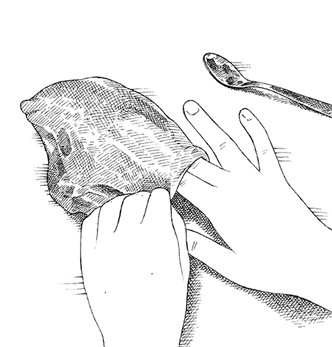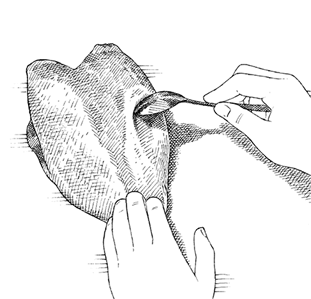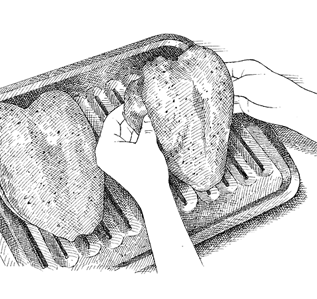The Cook's Illustrated Cookbook (151 page)
Read The Cook's Illustrated Cookbook Online
Authors: The Editors at America's Test Kitchen
Tags: #Cooking

SERVES 4
We prefer to split whole chicken breasts ourselves because store-bought split chicken breasts are often sloppily butchered. However, if you prefer to purchase split chicken breasts, try to choose 10- to 12-ounce pieces with skin intact. If using kosher chicken, do not brine in step 1, and season with salt as well as pepper. The chicken can be prepared without the pan sauce; if not making a pan sauce, let the chicken rest for 5 minutes before serving in step 4.
CHICKEN
¹⁄ | cup salt |
2 | (1¹⁄ |
Pepper | |
1 | tablespoon vegetable oil |
SAUCE
1 | large shallot, minced |
³⁄ | cup low-sodium chicken broth |
¹⁄ | cup dry vermouth |
4 | fresh sage leaves, each leaf torn in half |
3 | tablespoons unsalted butter, cut into 3 pieces and chilled |
Salt and pepper |
1. FOR THE CHICKEN:
Dissolve salt in 2 quarts cold water in large container. Submerge chicken in brine, cover, and refrigerate for 30 to 60 minutes. Remove chicken from brine and pat dry with paper towels. Season chicken with pepper.
2.
Adjust oven rack to lowest position and heat oven to 450 degrees. Heat oil in 12-inch ovensafe skillet over medium-high heat until just smoking. Place chicken breasts skin side down in skillet and cook until well browned, 6 to 8 minutes, reducing heat if pan begins to scorch. Flip chicken skin side up and continue to cook until lightly browned on second side, about 3 minutes.
3.
Flip chicken skin side down and transfer skillet to oven. Roast until chicken registers 160 degrees, 15 to 18 minutes.
4.
Using potholders (skillet handle will be hot) remove skillet from oven. Transfer chicken to serving platter and let rest while making sauce (if not making sauce, let chicken rest 5 minutes before serving).
5. FOR THE SAUCE:
Being careful of hot skillet handle, pour off all but 1 teaspoon fat left in skillet, add shallot, and cook over medium-high heat until softened, about 2 minutes. Stir in chicken broth, vermouth, and sage leaves, scraping up any browned bits. Bring to simmer and cook until thickened and measures ³⁄
4
cup, about 5 minutes. Stir in any accumulated chicken juices; return to simmer and cook for 30 seconds.
6.
Off heat, discard sage leaves and whisk in butter 1 piece at a time. Season with salt and pepper to taste. Pour sauce over chicken and serve immediately.
Substitute 7 sliced garlic cloves for shallot and cook, stirring often, until garlic turns golden but not brown, about 1¹⁄
2
minutes. Substitute dry sherry for dry vermouth and 2 sprigs fresh thyme for sage leaves. Stir ¹⁄
2
teaspoon lemon juice into sauce before seasoning with salt and pepper.
Brown ale gives this sauce a nutty, toasty, bittersweet flavor. Newcastle Brown Ale and Samuel Smith Nut Brown Ale are good choices.
Substitute ¹⁄
2
onion, sliced very thin, for shallot and cook until onion is softened, about 5 minutes. Substitute ¹⁄
2
cup brown ale for dry vermouth and 1 sprig fresh thyme for sage. Stir 1 bay leaf and 1 tablespoon brown sugar into skillet along with chicken broth. Stir ¹⁄
2
teaspoon cider vinegar into sauce before seasoning with salt and pepper.
This sauce is a variation on the Italian sweet-sour flavor combination called agrodolce.
Substitute ¹⁄
4
cup red wine and ¹⁄
4
cup red wine vinegar for dry vermouth and 1 bay leaf for sage leaves. Stir 1 tablespoon sugar and ¹⁄
4
teaspoon pepper into skillet with chicken broth.
![]() WHY THIS RECIPE WORKS
WHY THIS RECIPE WORKS
Recipes for roasted chicken breasts often produce bland, dry meat and flabby skin. Attempts to cover up such disappointment with potent ingredients only make matters worse for this simple dish. We discovered that cooking whole (rather than split) breasts helped the meat retain more moisture. Before serving, we simply carved the meat off the bone into thin slices for an attractive presentation. Elevating the meat was also key: we not only perched the chicken on the slotted top of a broiler pan, but also created a natural rack by pulling out the rib cage on each side of the whole breast so that it could stand up on its own, allowing the heat to circulate evenly around the meat. Gently separating the skin from the meat and rubbing butter and salt underneath the skin and oil on top further guaranteed ultra-crisp skin and well-seasoned meat.
See “PREPARING CHICKEN BREASTS FOR ROASTING” illustrations that follow recipe.
SERVES 4
To make sure that the breasts cook at the same rate, purchase 2 similarly sized whole breasts (not split breasts) with skins fully intact. Whole chicken breasts weighing about 1¹⁄
2
pounds work best because they require a cooking time long enough to ensure that the skin will brown and crisp nicely.
2 | tablespoons unsalted butter, softened |
Salt and pepper | |
2 | (1¹⁄ |
1 | tablespoon vegetable oil |
1.
Adjust oven rack to middle position and heat oven to 450 degrees. Set wire rack in aluminum foil–lined rimmed baking sheet.
2.
Combine butter and ¹⁄
4
teaspoon salt in bowl. Pat chicken dry with paper towels. Using your hands or handle of wooden spoon, gently loosen center portions of skin covering each breast. Place butter (about 1¹⁄
2
teaspoons per breast) under skin, directly on meat in center of each breast. Gently press on skin to distribute butter evenly over meat. Rub skin with oil and season with pepper. Set chicken breasts on prepared wire rack, propping up breasts on rib bones.
3.
Roast until chicken registers 160 degrees, 35 to 40 minutes. Transfer chicken to carving board and let rest for 5 minutes. Carve chicken and serve.
Microwave ¹⁄
4
cup water and 2 tablespoons dried porcini mushrooms in covered bowl until steaming, about 1 minute. Let stand until softened, about 5 minutes. Drain mushrooms through fine-mesh strainer lined with coffee filter, discarding liquid and finely chopping mushrooms. Mix chopped mushrooms, 1 teaspoon minced fresh thyme, and 1 teaspoon minced fresh rosemary into softened butter along with salt.
Mix 2 minced garlic cloves, 2 teaspoons minced fresh rosemary, and 1 teaspoon grated lemon zest into softened butter along with salt.
Mix 2 teaspoons minced canned chipotle chile in adobo, 1 teaspoon ground cumin, and 2 teaspoons chopped fresh cilantro into softened butter along with salt.
Mix 1 tablespoon chopped pitted kalamata olives, 1 teaspoon grated lemon zest, and 2 teaspoons chopped fresh parsley into softened butter along with salt.

1.
Gently lift skin at bottom of breast to create small pocket for butter.

2.
Using your fingers or small spoon, place one-quarter of butter in center of each breast. Gently press on skin to spread butter over meat.

3.
Carefully pull out rib cage from each side of breast to create stable base.
![]() WHY THIS RECIPE WORKS
WHY THIS RECIPE WORKS
Roasting a whole chicken requires some planning, and even then it can be a challenge to cook. We wanted to shorten the preparation and cooking time without sacrificing crisp skin. To do so, we turned to pan-roasting. We cut up a whole chicken into eight pieces, which fit comfortably in a 12-inch skillet. Brining took just 30 minutes and added welcome flavor and moisture. Before roasting the chicken pieces, we browned them on both sides in oil on the stovetop, turned the chicken skin side down, then slid the pan into a 450-degree oven to finish cooking. The whole process took only 20 minutes. Once the chicken was removed from the skillet, the fond was crusty and plentiful, so we needed only a handful of ingredients—some minced shallot, chicken broth, vermouth, thyme, and butter—to turn it into a flavorful sauce.
See “CUTTING UP A WHOLE CHICKEN” illustrations that follow recipe.
